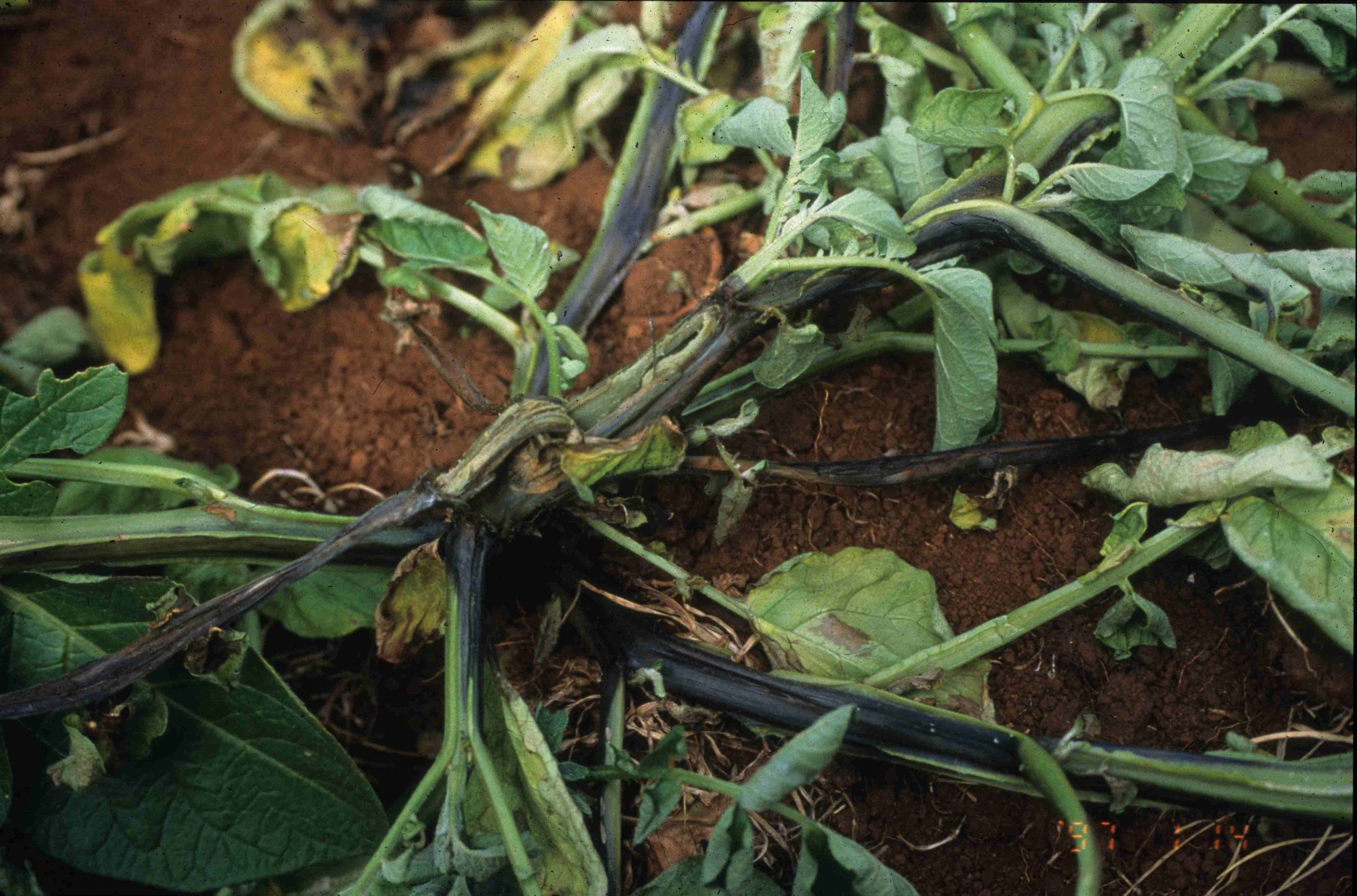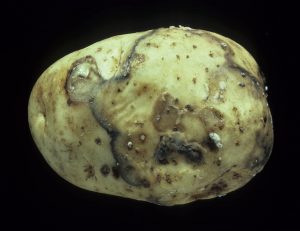
Latest Harvest to Home Comprehensive review: Beans
7 April 2020
Advancing robotics in the Australian vegetable industry
8 April 2020The detection of an exotic bacterium that causes potato blackleg disease in Western Australia in 2017 prompted a review of world literature and recommendations to the Australian potato industry. Plant pathologist Dr Len Tesoriero conducted the review, and he shared the key findings and R&D gaps for industry with Potatoes Australia in April 2019.
The soft rot bacterial species Dickeya and Pectobacterium are listed globally in the top 10 of important bacterial plant pathogens based on their economic impact. They are comprised of a genetically diverse group of plant pathogens affecting a wide range of plant species.
Globally there has been some alarm in recent years at the increasing diversity and geographical spread of bacterial pathogens that cause potato blackleg and soft rots. Their host ranges can extend across many other horticultural commodities, which further complicate biosecurity arrangements and trade. Post-harvest losses are greatest in poorer countries that lack refrigerated cool chain practices.
In Australia, crop losses from potato blackleg disease are generally considered to be low; however, there are cases of greater losses occurring when wet and windy weather conditions prevail, or of soft rots developing after planting seed tubers into warmer soils.
Unfortunately, there are some species described overseas that cause serious potato diseases that have not been recorded in Australia.
Our ‘pest-free’ status is not assured though, for three key reasons:
- There have been few potato crop surveys targeting these pathogens.
- These bacteria have undergone several name changes over the past decades.
- Several newly-named species and subspecies have been reported with the use of genetic classification techniques.
This has led to confusion with our pathogen records. For example, isolates preserved in state bacterial collections may now have different names.
This raises the question: is it possible that we already have some of these proposed biosecurity threats?
Multiple hosts – our open biosecurity pathways
Many of these bacteria can also infect other plant species. For instance, ornamental bulbs have been shown to spread some of these bacterial pathogens overseas. One recent case from China reported the detection of the serious potato soft rot pathogen, Dickeya solani, in hyacinth bulbs originating in Europe. This suggests Australia has an open pathway for the introduction of these bacteria as we have a long history of importing bulbs. Similarly, vegetative plant material imported for the nursery and cut flower industries could be symptomless carriers of some of these bacteria.
Indeed, the Western Australian detection of the Dickeya dianthicola bacterium causing blackleg in 2017 was a lesson of how these bacteria can spread between different commodities. It has been determined that dahlia bulbs grown in the field prior to the potatoes were the likely origin of the bacterium in this case.
Current best management practices
Unfortunately there are no simple solutions to controlling bacterial plant diseases. However, a key recommendation is to re-focus attention on the best management practices that can currently be implemented. For instance, the disease preventative role pertaining to using certified seed was reported in the June/July 2018 edition of Potatoes Australia.
Following are a number of integrated management options for potato blackleg and soft rots that growers should implement on-farm.
- Planting whole seed rather than cut seed, particularly in regions where tuber soft rot and blackleg diseases have been a problem (such as in warm or wet soils).
- Scheduling planting to avoid periods when extremely wet conditions or high temperatures prevail. • Using long crop rotations of 2-8 years, particularly for seed production.
- Avoiding risks of cross-contamination between alternative host crops such as ornamental bulbs or vegetable crops grown in the same fields, or using machinery or personnel that could spread bacteria on a farm.
- Manage plant insect pests to avoid physical injuries to tubers, roots and stems that provide entry sites for bacteria.
- Potato processing companies use modern coolstores (such as Dutch environment control technologies) for potatoes, which have led to significantly reduced postharvest losses from tuber breakdown due to soft rot bacteria.
- Careful management of plant nutrition and soil moisture. Maintaining optimal calcium and magnesium levels in plants, and optimal soil moisture through irrigation management and adequate drainage are well-known management strategies to help plants resist blackleg and soft rot infections.
Australian horticulture does not permit the use of antibiotics and where they have been used overseas, a rapid development of resistance in bacterial populations ensued or their use has been discontinued due to other environmental health concerns.
Similarly, disinfection of potato tubers by steaming, hot dry air, ultraviolet radiation and various inorganic salts and antimicrobials have been investigated and were found to have some efficacy under controlled experimental conditions, but have not been proven effective in practice.
There are no single genes known that confer resistance to these bacterial pathogens and given their wide genetic diversity and propensity to acquire new genes, it is unlikely conventional breeding programs will yield anything more than varieties with reduced susceptibility to certain bacterial strains.
Current overseas research with novel genome editing technologies such as CRISPR and breeding programs based on diploid potato lines may provide future promise (diploid is a cell or an organism consisting of two sets of chromosomes – standard potato varieties are tetraploid, that is, with four sets of chromosomes).
Looking ahead
There are competing interests when considering a way forward. On the one hand, accurately estimating biosecurity risks and implementing appropriate mitigation or management strategies for these bacteria would require surveying and determining the current status of the Australian potato industry.
However, there may be economic implications that follow from reporting bacteria not previously recorded in Australia. In particular, export and interstate trade in seed or ware potatoes may be adversely affected. Closing the perceived open biosecurity pathway by tightening quality controls for imported ornamental bulbs and vegetative nursery plants and cut flowers also comes with an economic cost and requires negotiations with other industries and government agencies.
At the very least, the potato industry should consider the following approach as a way forward:
- Review the bacteria that are currently lodged in Australian collections.
- Access and validate new diagnostic tests which include the capability to distinguish important subspecies of these bacterial pathogens. Test validation will need to ensure there is no interference from related environmental bacterial species.
- There are current R&D projects in the vegetable and nursery industries that should focus on characterising bacteria that may also impact potatoes. These studies will inform authorities of any need to review potato seed production guidelines and any considerations for national and regional quarantine and biosecurity.
Find out more
Please contact Dr Len Tesoriero at len.tesoriero@dpi.nsw.gov.au.
The final report for Review of bacterial blackleg diseases and R&D gaps with a focus on the potato industry is available on InfoVeg.
This project was funded by Hort Innovation using the fresh potato and potato processing research and development levies and contributions from the Australian Government.
Project Number: PT18000


